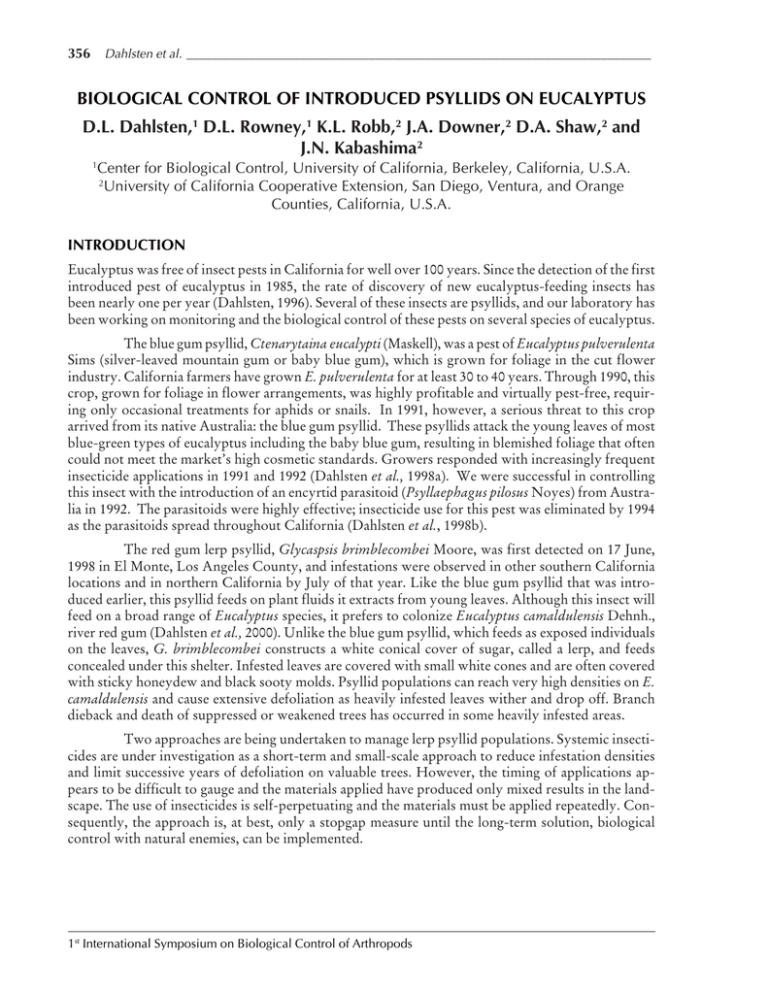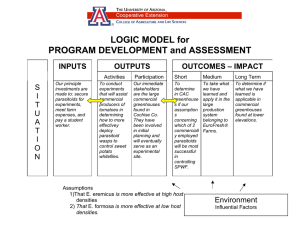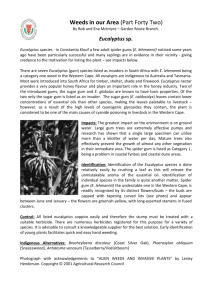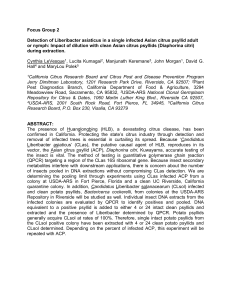BIOLOGICAL CONTROL OF INTRODUCED PSYLLIDS ON EUCALYPTUS D.L. Dahlsten, D.L. Rowney, K.L. Robb,
advertisement

356 Dahlsten et al. __________________________________________________________________________ BIOLOGICAL CONTROL OF INTRODUCED PSYLLIDS ON EUCALYPTUS D.L. Dahlsten,1 D.L. Rowney,1 K.L. Robb,2 J.A. Downer,2 D.A. Shaw,2 and J.N. Kabashima2 1 Center for Biological Control, University of California, Berkeley, California, U.S.A. 2 University of California Cooperative Extension, San Diego, Ventura, and Orange Counties, California, U.S.A. INTRODUCTION Eucalyptus was free of insect pests in California for well over 100 years. Since the detection of the first introduced pest of eucalyptus in 1985, the rate of discovery of new eucalyptus-feeding insects has been nearly one per year (Dahlsten, 1996). Several of these insects are psyllids, and our laboratory has been working on monitoring and the biological control of these pests on several species of eucalyptus. The blue gum psyllid, Ctenarytaina eucalypti (Maskell), was a pest of Eucalyptus pulverulenta Sims (silver-leaved mountain gum or baby blue gum), which is grown for foliage in the cut flower industry. California farmers have grown E. pulverulenta for at least 30 to 40 years. Through 1990, this crop, grown for foliage in flower arrangements, was highly profitable and virtually pest-free, requiring only occasional treatments for aphids or snails. In 1991, however, a serious threat to this crop arrived from its native Australia: the blue gum psyllid. These psyllids attack the young leaves of most blue-green types of eucalyptus including the baby blue gum, resulting in blemished foliage that often could not meet the market’s high cosmetic standards. Growers responded with increasingly frequent insecticide applications in 1991 and 1992 (Dahlsten et al., 1998a). We were successful in controlling this insect with the introduction of an encyrtid parasitoid (Psyllaephagus pilosus Noyes) from Australia in 1992. The parasitoids were highly effective; insecticide use for this pest was eliminated by 1994 as the parasitoids spread throughout California (Dahlsten et al., 1998b). The red gum lerp psyllid, Glycaspsis brimblecombei Moore, was first detected on 17 June, 1998 in El Monte, Los Angeles County, and infestations were observed in other southern California locations and in northern California by July of that year. Like the blue gum psyllid that was introduced earlier, this psyllid feeds on plant fluids it extracts from young leaves. Although this insect will feed on a broad range of Eucalyptus species, it prefers to colonize Eucalyptus camaldulensis Dehnh., river red gum (Dahlsten et al., 2000). Unlike the blue gum psyllid, which feeds as exposed individuals on the leaves, G. brimblecombei constructs a white conical cover of sugar, called a lerp, and feeds concealed under this shelter. Infested leaves are covered with small white cones and are often covered with sticky honeydew and black sooty molds. Psyllid populations can reach very high densities on E. camaldulensis and cause extensive defoliation as heavily infested leaves wither and drop off. Branch dieback and death of suppressed or weakened trees has occurred in some heavily infested areas. Two approaches are being undertaken to manage lerp psyllid populations. Systemic insecticides are under investigation as a short-term and small-scale approach to reduce infestation densities and limit successive years of defoliation on valuable trees. However, the timing of applications appears to be difficult to gauge and the materials applied have produced only mixed results in the landscape. The use of insecticides is self-perpetuating and the materials must be applied repeatedly. Consequently, the approach is, at best, only a stopgap measure until the long-term solution, biological control with natural enemies, can be implemented. 1st International Symposium on Biological Control of Arthropods ___________________________________ Biological control of introduced psyllids on eucalyptus 357 On August 14, 2000 a new insect was discovered on lemon-scented gum (Corymbia citriodora Hook.) near the Los Angeles Airport. The spotted gum psyllid, Eucalytolyma maideni Froggatt, is the latest eucalyptus pest to enter California from Australia. We are monitoring for this psyllid and we will be exploring for potential Australian parasitoid biological control agents. As we describe in the next section, the research programs supported by the University of California IPM program have quickly provided solutions to the most serious of these pest problems. However, the continuing introduction of new insect pests potentially jeopardizes the balances achieved in these successful IPM programs. Management solutions for the most serious of the most recently introduced pests are under investigation. METHODS Sampling for Red Gum Lerp Psyllid In February 1999, we established monitoring sites for adult red gum lerp psyllids. A monitoring site usually consisted of 10 sticky traps. We used the same type of sticky traps that we used for the blue gum psyllid and the eugenia psyllid (Trioza eugeniae Froggatt), i.e., a 10.5 cm diameter transparent plastic lid (87 cm2) coated with motor oil additive that fits over another, permanently placed, yellowpainted lid. This system allows traps to be changed efficiently. By 2001, we had established 30 monitoring sites throughout the state (Fig. 1), including both coastal and inland sites. With the help of many cooperators we changed traps weekly, and this added up to 350 trap samples per week. The traps were also useful for monitoring adult parasitoids. We initially sampled foliage every three weeks at two locations, one in Los Angeles and another at Ardenwood in Alameda County for 18 months. Two 30 cm branches were taken in the vicinity of the 10 sticky traps in each plot, and all the eggs and nymphal stages of the psyllid were counted. There was a strong relationship between the number of adult females caught in the sticky traps and the immature stages on the foliage samples, particularly eggs (R2= 0.78). This relationship indicates that the sticky traps are a reliable method for estimating psyllid populations (Paine et al., 2000). Since 2001, we have taken foliage samples at sites where parasitoids are present in order to determine the relationship between numbers of adult parasitoids and levels of parasitism. Parasitoid Exploration and Rearing In August 1999, Dahlsten collected psyllids in two regions of Australia, in search of natural enemies of the lerp psyllid. The climate of these areas was determined to closely match that of central and southern coastal California. Eight species of Psyllaephagus (encyrtid parasitoid wasps) were reared from two species of Glycaspis psyllids in our quarantine facility at the University of California, Berkeley. These wasps were reared in quarantine on California-collected lerp psyllids and tested for suitability as biological control agents against the red gum lerp psyllid. We have determined that one, Psyllaephagus faustus Riek, is a hyperparasite and will attack mummies of G. brimblecombei as well as mummies of the blue gum psyllid, C. eucalypti. Our most promising candidate, Psyllaephagus bliteus Riek, is currently being produced at the University of California at Berkeley Insectary, as well as at the California Department of Food and Agriculture Insectary in Sacramento. A series of host specificity tests were conducted with P. bliteus on red gum lerp psyllid and three other psyllid species: eugenia psyllid, blue gum psyllid, and melaleuca psyllid (Boreioglycaspis melaleucae Moore). The testing of melaleuca psyllid was of particular concern as it is a United States Department of Agriculture candidate for the biological control of Australian paper bark tree (Melaleuca quinqunervia [Cav.] S.T.) in the Florida Everglades. 1st International Symposium on Biological Control of Arthropods 358 Dahlsten et al. __________________________________________________________________________ Glenn Tehema Sonoma Solano San Mateo Sacramento Alameda Santa Clara Merced Fresno Monterey San Luis Obispo Santa Barbara Ventura Los Angeles San Bernardino Orange Riverside San Diego Imperial Figure 1. Red gum lerp psyllid sample sites, parasitoid release locations, and recovery counties in California, December 2001. We have had considerable difficulty with the mass rearing of this small wasp. First we had problems getting enough small red gums to establish a psyllid population and then we discovered that there were many more male psyllids than females most of the year. Finally we found that there was a long host-feeding period for the female wasps when they kill psyllid nymphs rather than parasitizing them. 1st International Symposium on Biological Control of Arthropods ___________________________________ Biological control of introduced psyllids on eucalyptus 359 RESULTS AND DISCUSSION Monitoring We are currently monitoring with traps in 30 sites throughout the state covering 18 counties (Fig. 1). All of these areas have damaging levels of lerp psyllids, but the highest levels observed so far are in the Los Angeles area (Fig. 2). Female psyllids generally make up less than 40% of total psyllids on traps, but because females are the best indicator of psyllid eggs and immatures on foliage, only females are plotted (Fig. 2). 0.4 12 120 8 80 4 40 Parasitoids / Trap Parasitoid release Parasitoid release 160 Psyllids / Trap 0.5 16 0.3 0.2 Proportion Female 200 0.1 0 Jul Sep Nov Jan Mar May Jul Sep Nov Jan Mar May Jul Sep Nov 1999 0 0.0 2001 2000 Female red gum lerp psyllid Parastitoids Proportion female psyllids Figure 2. Red gum lerp psyllid females per trap, proportion female psyllids, and parasitoids per trap, Griffith Park, Los Angeles, California, 1999-2001. Host Specificity Testing We have tested P. bliteus on the blue gum psyllid, the eugenia psyllid, and on mummies of G. brimblecombei and the blue gum psyllid. All these tests were negative. Cooperating with USDA Agricultural Research Service, Ray Carruthers and John Herr in Albany and Gary Buchingham in Florida, we have tested our parasitoid on B. melaleucae, a psyllid that is a candidate as a biological control agent on Australian paper bark tree (melaleuca) in the Florida Everglades. These results were also negative. 1st International Symposium on Biological Control of Arthropods 360 Dahlsten et al. __________________________________________________________________________ Release and Establishment of P. bliteus From spring 2000 to fall 2001, we reared and released over 17,000 parasitoids at 39 locations (Fig. 1). Initial releases in 2000 were small (average 100 parasitoids in 19 releases) because rearing the parasitoids required a high commitment of resources for relatively small yields. In 2001, average release numbers increased to 375, as we were able to increase production and also rear parasitoids from fieldcollected material from sites with earlier establishment. Our first parasitoid releases were in June 2000, and by late August 2000 we recovered parasitoids in one site (Redwood City) 15 km from the nearest release point. Only one other recovery was made (Valley Village Park, Los Angeles) in 2000. However by summer-fall 2001 recoveries had become common in nine California coastal counties at a total of 21 sites. In California’s central valley, nine parasitoid releases were made in five counties having high psyllid infestations; however, no recoveries have yet been made. We are planning further studies to determine if temperature or other factors are affecting establishment of the parasitoid in the central valley or other inland areas. Effectiveness of P. bliteus for Biological Control The first year in which parasitoids were detected in significant numbers was 2001. At most sites, where parasitoids are just beginning to be detected, there has not yet been significant change in psyllid levels from previous years. At several sites where establishment occurred earlier, however, the parasitoids show indications of potential effectiveness. At the Griffith Park plot (Fig. 2) where parasitoids were first detected in August 2001, numbers of parasitoids increased significantly by October 2001, while populations of psyllid females decreased by one-half compared with October 2000. In two plots at Torrance, Los Angeles County, parasitoids became common after August 2001, and psyllid female levels were significantly lower by October than in the previous two years. At Scripps Ranch, San Diego, a site with relatively low psyllid densities, parasitoids appeared in June 2001, and from August to October in 2001, psyllid female densities were many times lower than in the same period in 2000. After the spring-summer 2002 season we should be able to tell if this parasitoid will be effective for control of the red gum lerp psyllid in California coastal areas. ACKNOWLEDGMENTS Cooperators: Cheryl Willen–University of California IPM Advisor, San Diego; Dave Kellum–San Diego Co.; Rosser Garrison–Los Angeles Co.; Jolene Carson–Imperial Co.; Jerry Davidson–Santa Barbara Co.; Nick Nisson–Orange Co.; Pricilla Lane–Sonoma Co.; Janica Jones–Los Angeles Zoo; Teresa Proscewicz–Los Angeles City Dept. Recreation and Parks; George Gonzalez –Los Angeles City Bureau of Street Services; Laura Adams–Los Angeles Co. Sanitation District; Monty Chamness– Torrance Street Services Dept.; Nancy Brownfield–East Bay Regional Parks District; Herb Fong– Grounds Dept., Stanford University; Larry Bezark, Ray Gill, Bill Roltsch, and Joe Ball–California Department of Food and Agriculture; Ray Carruthers and John Herr–United States Department of Agriculture; Steve Dreistadt and Mary Louise Flint–University of California IPM; Mary Bianchi, Larry Costello, Mark Hoddle, Kent M. Daane, Pamela Geisel, Bill Kruger, Richard Buchner, and Chuck Ingels–University of California Cooperative Extension 1st International Symposium on Biological Control of Arthropods ___________________________________ Biological control of introduced psyllids on eucalyptus 361 REFERENCES Dahlsten, D. L. 1996. Introduced Eucalyptus foliage feeders in California, pp. 32-35. In Anon. Proceedings of the 44th Annual Meeting of the California Forest Pest Council. Sacramento, California, November 16-17, 1995. Dahlsten, D. L., E. P. Hansen, R. L. Zuparko, and R. B. Norgaard. 1998. Biological control of the blue gum psyllid proves economically beneficial. California Agriculture 52(1): 35-40. Dahlsten, D. L., D. L. Rowney, W. A. Copper, R. L. Tassan, W. E. Chaney, K. L. Robb, S. Tjosvold, M. Bianchi, and P. Lane. 1998. Parasitoid wasp controls blue gum psyllid. California Agriculture 52(1): 31-34. Dahlsten, D. L., D. L. Rowney, A. B. Lawson, W. E. Chaney, K. L. Robb, L. R. Costello, and J. N. Kabashima. 2000. The red gum lerp psyllid, a new pest of Eucalyptus species in California, pp. 45-50. In Jones, S. M., Adams, D. M., and J. E. Rios (eds.). Proceedings of the 48th Annual Meeting of the California Forest Pest Council. Sacramento, California, November 18-19, 1999. California Department of Forestry and Fire Protection. Paine, T. D., D. L. Dahlsten, J. G. Millar, M. S. Hoddle, and L. M. Hanks. 2000. U.C. scientists apply IPM techniques to new eucalyptus pests. California Agriculture 54(6): 8-13. 1st International Symposium on Biological Control of Arthropods




